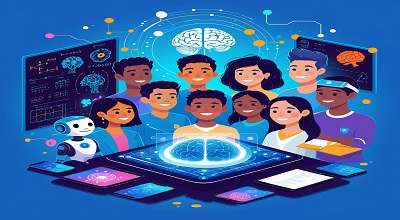AI in Education
AI in Education: Artificial Intelligence (AI) is revolutionizing various industries, and education is no exception. AI-powered tools are enhancing learning experiences, automating administrative tasks, and providing personalized education to students worldwide.
With advancements in machine learning, natural language processing (NLP), and data analytics, AI is making education more accessible, efficient, and engaging. From intelligent tutoring systems to automated grading, AI is reshaping how teachers teach and students learn.
How AI is Transforming Education?
AI is transforming education in multiple ways, including:
A. Personalized Learning
AI algorithms analyze students’ learning patterns and adapt content to their needs. Platforms like Knewton and DreamBox provide customized lessons based on individual progress.
B. Intelligent Tutoring Systems
AI-powered tutors, such as Carnegie Learning and Squirrel AI, offer real-time assistance, helping students with difficult concepts outside the classroom.
C. Automated Grading & Feedback
Tools like Gradescope and Turnitin use AI to evaluate assignments, essays, and coding exercises, reducing teachers’ workload.
D. Virtual Classrooms & Chatbots
AI-driven platforms like Zoom AI Companion and Google’s Duet AI enhance virtual learning with real-time transcription and smart replies. Chatbots like Jill Watson (Georgia Tech) assist students with queries.
E. Predictive Analytics for Student Success
AI analyzes student data to predict dropout risks and learning gaps, helping institutions intervene early.
Latest Examples of AI in Education
Here are some cutting-edge AI applications in education:
A. ChatGPT in Education
- Used for generating lesson plans, answering student questions, and providing writing assistance.
- Platforms like Khan Academy integrate ChatGPT for tutoring.
B. Google’s AI-Powered NotebookLM
- An AI-first notebook that helps students organize and summarize research.
C. Duolingo Max (Powered by GPT-4)
- Offers AI-driven explanations and role-playing exercises for language learners.
D. Cognii’s AI for Essay Grading
- Uses NLP to assess open-ended responses with detailed feedback.
E. IBM Watson Education
- Provides AI-driven insights for personalized learning pathways.
F. ALEKS (Assessment & Learning in Knowledge Spaces)
- An adaptive learning platform that tailors math and science content.
Benefits of AI in Education
- Personalized Learning: Adapts to each student’s pace and style.
- Efficiency: Automates grading and administrative tasks.
- Accessibility: Supports students with disabilities via speech-to-text and text-to-speech tools.
- Engagement: Gamified AI apps make learning interactive.
- Data-Driven Decisions: Helps educators identify at-risk students.
Challenges and Ethical Considerations
While AI offers immense benefits, challenges include:
- Data Privacy: Ensuring student data security.
- Bias in AI: Algorithms may reflect human biases.
- Over-reliance on AI: Risk of reducing human interaction in learning.
- Cost: High implementation expenses for schools.
Future of AI in Education
The future holds: Exhibit Of Sorrows Clown APK
- AI-Powered Virtual Reality (VR) Classrooms
- More Advanced Adaptive Learning Systems
- AI Collaborating with Teachers (Not Replacing Them)
- Global Access to Quality Education via AI
Free Download:
Conclusion
AI is reshaping education by making learning more personalized, efficient, and inclusive. While challenges exist, the potential benefits are transformative. Educators and institutions must embrace AI responsibly to maximize its impact.
FAQs
Q1: How does AI personalize learning for students?
AI analyzes students’ strengths and weaknesses, adjusting lessons in real-time to match their learning pace.
Q2: Can AI replace teachers?
No, AI assists teachers by automating tasks but cannot replace human mentorship and emotional support.
Q3: Is AI in educations expensive to implement?
Initial costs can be high, but many affordable AI tools (like ChatGPT and free LMS integrations) are available.
Q4: What are the risks of AI in educations?
Data privacy concerns, algorithmic bias, and reduced human interaction are key risks.
Q5: Which AI tool is best for language learning?
Duolingo Max and Rosetta Stone’s AI-powered features are leading options.
